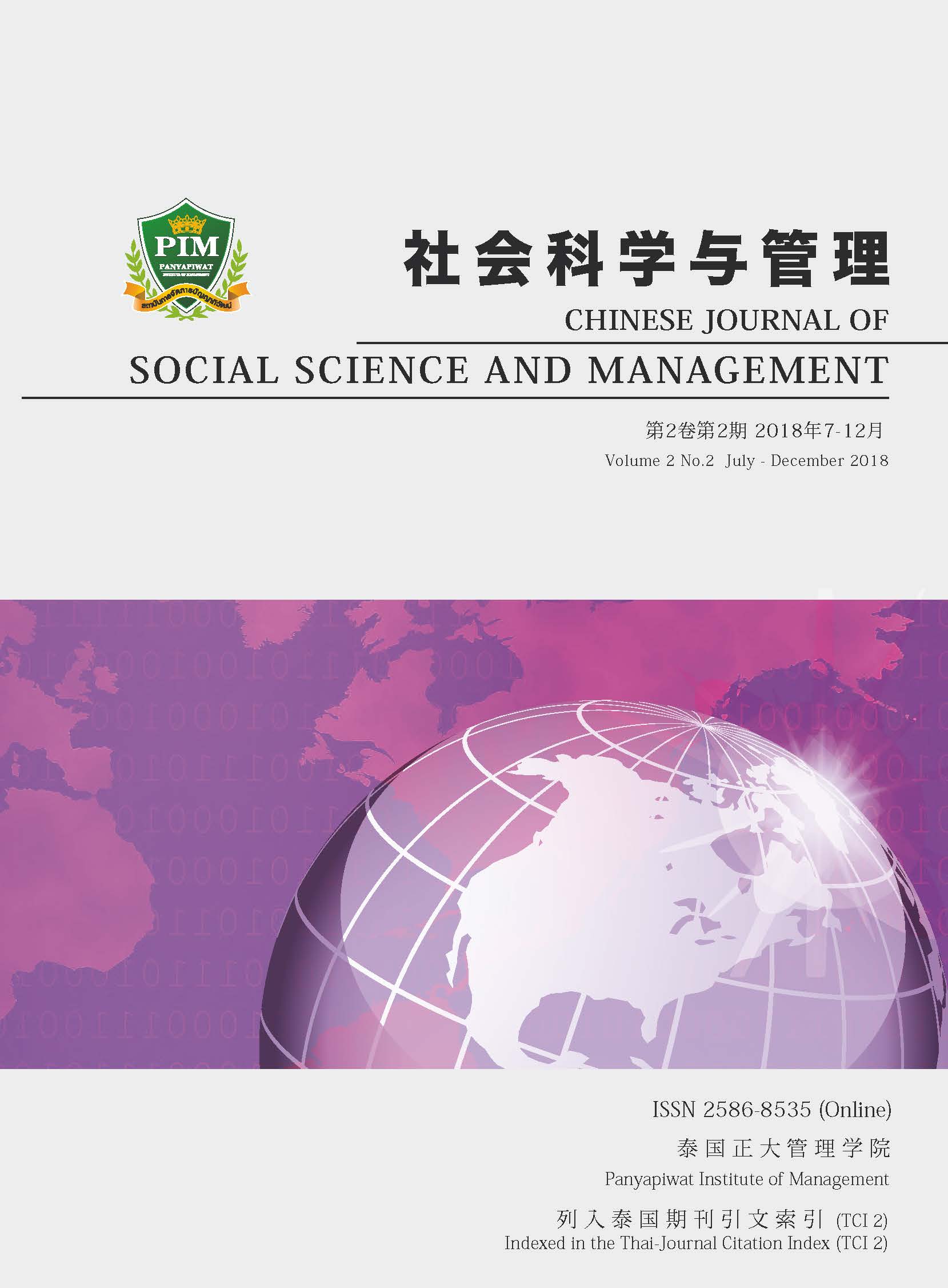REVISION OF CHINESE STAFF ORGANIZATIONAL COMMITMENT QUESTIONNAIRE
Main Article Content
Abstract
The purpose of this research was to explore the structure of staff’s organizational commitment
in the context of Chinese culture and to revise Chinese Organizational Commitment Questionnaire
(COCQ). Based on the Chinese staff organizational commitment structure theory of Ling Wenquan and
analysis of 25 employee interviews by sandplay we designed the draft of COCQ which is consisted of
58 items on the 10-factor structure of Chinese staff organization commitment. We used exploratory
factor analysis (482 participants) to change the COCQ (58 items) and confirmatory factor analysis
(367 participants) to verify the COCQ (34 items) Exploratory factor analysis revealed and confirmed the
10 factor structure of organizational commitment in the context of Chinese culture. Confirmatory factor
analysis supported a 34-item, 10-factor structure of the COCQ. In addition, the COCQ were internally
consistent. The fitting degree of the COCQ is at an acceptable level, the questionnaire has a good
discriminant validity, and the aggregate validity of the dimensions of the questionnaire is relatively high.
The COCQ updated the sources and types of commitments in the Chinese staff organizational commitment
structure theory of Ling Wenquan to develop a 10-dimensional scale; the COCQ was a measurement tool
with good reliability and validity
Article Details
Chinese Journal of Social Science and Management Editorial Division
The Office of Research and Development, Panyapiwat Institute of Management
85/1 Moo 2, Chaengwattana Rd., Bang Talat, Pakkred, Nonthaburi 11120, Thailand
Tel. 02 855 01048 E-mail: cjssm@pim.ac.th
References
Allen, N. J. & Meyer, J. P. (1996). Affective, continuance, and normative commitment to the organization. Journal of Vocational Behavior, 49, 252-276.
Angle, H. L. & Perry, J. L. (1981). An empirical assessment of organizational commitment and organizational effectiveness. Administrative Science Quarterly, 27, 1-14.
Bentein, K., Vandenberg, R. J., Vandenberghe, C. & Stinglhamber, F. (2005). The role of change in the relationship between commitment and turnover: A latent growth modeling approach. Journal of Applied Psychology, 90, 468-482.
Buchanan, B. (1974). Building organizational commitment: The socialization of managers in work organizations. Administrative Science Quarterly, 19, 533-546.
Cai, C. H. & Liu, Z. J. (2010). Jung actively imagined technology and sandplay therapy. Education Guide, 11(9), 58. [in Chinese]
Cohen, A. (2003). Multiple commitments in the workplace: An integrative approach. Mahwah, NJ: Erlbaum.
Cooper-Hakim, A. & Viswesvaran, C. (2005). The Construct of Work Commitment: Testing an Integrative Framework. Psychological Bulletin, 131, 241-259.
Cynthia, W. H. (2012). Personality, Organizational Commitment, And Job Search Behavior: A Field Study (Unpublished doctoral dissertation). University of Tennessee, Knoxville.
Greenberg, J. & Baron, A. B. (2003). Behavior in organizations (8th ed.). Upper Saddle River, NJ: Prentice Hall.
Jaros, S. J., Jermier, J. M., Koehler, J. W. & Singigh, T. (1993). Effects of continuance, affective, and moral commitment on the withdrawal process: An evaluation of eight structural equation
models. Academy of Management Journal, 36, 951-995.
Klein, H. J., Becker, T. E. & Meyer, J. P. (2009). Commitment in organizations: accumulated wisdom and new directions. New York: Routledge/ Psychology Press.
Ko, J. W., Price, J. L. & Mueller, C. W. (1997). Assessment of Meyer and Allen’s three-component model of organizational commitment in South Korea. Journal of Applied Psychology, 82, 961-973.
Ling, W. Q., Zhang, Z. C. & Fang, Y. L. (2000). Research on the structural model of Chinese employee organization commitment. Journal of Management Science, 3(2), 80. [in Chinese]
Mc Gee, G. & Ford, R. C. (1987). Two (or more?) dimensions of organizational commitment: Reexamination of the Affective and Continuous Commitment Scales. Journal of Applied Psychology, 72, 638-641.
Meyer, J. P. & Allen, N. J. (1984). Testing the side bet theory of organizational commitment: some methodological considerations. Journal of Applied Psychology, 69, 372-378.
Meyer, J. P. & Allen, N. J. (1991). A three-component conceptualization of organizational commitment. Human Resource Management Review, 1, 61-89.
Meyer, J. P., Allen, N. J. & Smith, C. A. (1993). Commitment to organizations and occupations: Extension and test of the three-component conceptualization. Journal of Applied Psychology, 78, 538-551.
Meyer, J. P., Stanley, D. J., Herscovitch, L. & Topolnytsky, L. (2002). Affective, Continuance, and Normative Commitment to the Organization: A Meta-analysis of Antecedents, Correlates, and Consequences. Journal of Vocational Behavior, 61, 20-52.
Mowday, R., Porter L. & Steers, R. (1982). Employee-organization link ages: The psychology of commitment, absenteeism, and turnover. New York: Academic Press.
Omar, N., Woody, V. & Robert, A. (2008). Beyond the Three-Component Model of Organizational Commitment. Journal of Applied Psychology, 93(1), 70-83.
O’Reilly, C. A. & Chatman, J. (1986). Organizational commitment and psychological attachment: The effects of compliance, identification, and internalization of prosocial behavior. Journal of Applied Psychology, 71, 492-499.
Powell, D. M. & Meyer, J. P. (2004). Side-bet theory and the three-component model of organizational commitment. Journal of Vocational Behavior, 65, 157-177.
Tan, W., Ling, W. Q. & Fang, Y. L. (2002). Verification of the five-factor structural model of Chinese workers’ organization commitment. Journal of Guangzhou University (Natural Science Edition), 1(6), 96. [in Chinese]
Vandenberg, R. J. & Self, R. M. (1993). Assessing newcomers’ changing commitments to the organization during the first 6 months of work. Journal of Applied Psychology, 78, 557-568.
Wang, P. & Huang, G. (2007). Research progress in the application of sandbox games in clinical psychology. Chinese Journal of Health Psychology, 15(9), 862-864. [in Chinese]
Zhang, R. S. (2005). Sandplay therapy. Beijing: People Education Press. [in Chinese]
Zhang, Z. C., Fang, Y. L. & Ling, W. Q. (2001). Structural model test of Chinese employee organization commitment. Psychological Science, 2, 148-150. [in Chinese]


